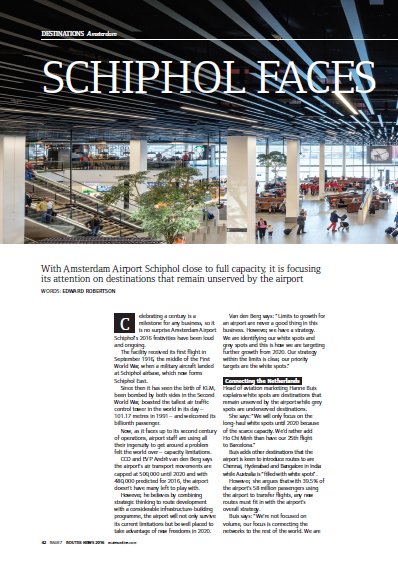Celebrating a century is a milestone for any business, so it is no surprise Amsterdam Airport Schiphol’s 2016 festivities have been loud and ongoing. The facility received its first flight in September 1916, the middle of the First World War, when a military aircraft landed at Schiphol airbase, which now forms Schiphol East.
Since then it has seen the birth of KLM, been bombed by both sides in the Second World War, boasted the tallest air traffic control tower in the world in its day – 101.17 metres in 1991 – and welcomed its billionth passenger. Now, as it faces up to its second century of operations, airport staff are using all their ingenuity to get around a problem felt the world over – capacity limitations.
CCO and EVP André van den Berg says the airport’s air transport movements are capped at 500,000 until 2020 and with 480,000 predicted for 2016, the airport doesn’t have many left to play with. However, he believes by combining strategic thinking to route development with a considerable infrastructure-building programme, the airport will not only survive its current limitations but be well placed to take advantage of new freedoms in 2020.
Van den Berg says: “Limits to growth for an airport are never a good thing in this business. However, we have a strategy. We are identifying our white spots and grey spots and this is how we are targeting further growth from 2020. Our strategy within the limits is clear, our priority targets are the white spots.”
Head of aviation marketing Hanne Buis explains white spots are destinations that remain unserved by the airport while grey spots are underserved destinations. She says: “We will only focus on the long-haul white spots until 2020 because of the scarce capacity. We’d rather add Ho Chi Minh than have our 25th flight to Barcelona.”
Buis adds other destinations that the airport is keen to introduce routes to are Chennai, Hyderabad and Bangalore in India while Australia is “filled with white spots”. However, she argues that with 39.5% of the airport’s 58 million passengers using the airport to transfer flights, any new routes must fit in with the airport’s overall strategy.
Buis says: “We’re not focused on volume, our focus is connecting the networks to the rest of the world. We are trying to work with airports and get the connections and build the traffic network.” Van den Berg agrees, adding: “Connecting the Netherlands remains our focus.”
Meanwhile, those airlines signing up for new routes will find the infrastructure is growing and evolving to fit their needs. A new pier will open by the end of 2019 while a new terminal is scheduled for 2023. Van den Berg says that in the first years of operation the new pier will be flexible with the ability to switch between accommodating three wide and five narrow-body aircraft or 11 narrow bodies. Meanwhile, the new terminal is expected to be able to handle 14 million passengers annually from its opening.
Van den Berg adds further piers are pencilled in for construction in the medium and long term, although the airport is at great pains to ensure it is listening to the airlines in order to ensure any future development is fit for purpose. He says: “Flexibility will be the answer to the requirements of the airlines. What we are doing is making intensive capital investment so we need to be flexible with what we build so that we are able to adapt it to these new requirements.”
Buis adds: “We have to factor in the airlines and ask what they want and why they are asking for it. We’re not only asking what kind of infrastructure they want but what is the use that they require from it. If they say they want a turnaround of 20 minutes, then we will go to the market and look at the best procedures to see how we can do that.”
She argues this approach is increasingly important as the barriers between different types of airlines continue to break down. “We are seeing business models merge, with hub carriers no longer doing two and a half hours on stand as they once did while only the low-cost carriers want quick turnarounds,” Buis says. “Now we see scheduled airlines asking for quick turnarounds as well. We try not to look at airline types, we look at demand types.”
While Schiphol is certainly making plans for the future, it is also dealing with immediate issues that are common across Europe. Security remains a key concern following the attacks on both Brussels and Istanbul’s Ataturk airports this year.
Van den Berg says: “Security is a huge issue and in the Netherlands we have a very good cooperation between the airport and the authorities. In the end we [the airport] are all learning our lessons from what has happened and we try and be aware of new measures.”
Buis adds: “The airport is growing, people are expecting a more seamless process and we need to find ways of getting more passengers through our airport process without delays. We are investing in that but it takes time before the system works perfectly. The whole digital process is probably the answer to all the queues, especially for the travellers.”
Van den Berg agrees, adding: “We’re working with the old models but preparing for the new ones; we are already transferring to a digital process. In a period of 5 to 10 years we will really see a huge change and I’m quite sure it will be drastic.”
He also remains relaxed about the news that rival airport London Heathrow could finally get a third runway after the UK government agreed to it in the autumn. This is despite the fact that of all the airport’s European passengers, the UK remains the single biggest market with 8.96 million Brits using the facility in 2015.
He adds that Schiphol is better connected to the UK than Heathrow with up to 27 destinations in the country. “The third runway will take a lot of time [to build] and we will be happy to serve a little longer as the third runway in Amsterdam. It will have some effect on Schiphol but it will not have such an effect that it will impact us [heavily].”
While Schiphol Airport Amsterdam is feeling the squeeze when it comes to capacity, one solution for the airport exists about 40 miles north east of Amsterdam.
Lelystad Airport opened in 1971 and was bought in 1993 by the Schiphol Group. It is currently home to aircraft offering business flights, general aviation, flight schools and maintenance, repair, and operations facilities. However, with plans to extend its 1,250-metre runway to 2,100 metres for 2018, the airport will be able to cater for Boeing 737s and Airbus A320s.
This will pave the way for commercial flights to operate aircraft to leisure destinations, giving Schiphol some breathing space when it comes to capacity. Buis, who takes up the role of Lelystad Airport managing director on January 1, 2017, said the leisure market will be key to the facility’s future success.
She said: “It is not focused on airlines, I cannot say that enough. It is really focused on tourism and leisure destinations. We still need to invest in it but we can create quit a lot of capacity by doing so. We want Schiphol to be the mainport in Amsterdam focused on other mainport traffic and business destinations. We are trying to make Lelystad serve as a leisure airport.”
Buis said in the first year of operation it is hoped the airport will handle between 2,000 and 3,000 air transport movements, although this could grow to 45,000 within a decade of full commercial operation. She added as well as easing the capacity pressure on Schiphol, airlines operating out of Lelystad can expect a number of other advantages, including lower fees.
Like everyone else in Europe, van den Berg remains perplexed as to what the UK’s vote to leave the European Union means both for the country and the continent as a whole.
He adds: “We have been discussing the issue for a few months now and it is really uncertain. So much depends on the negotiations that have to take place, how the EU’s current relationship with the UK will be replaced and what will replace it. We will be very ready for things should they change.” Which, given the amount of planning that has gone into the airport’s long-term future seems a plausible statement as to how it will deal with any short-term issues.
 |
This article is modified from an original feature that appeared in... ROUTES NEWS - ISSUE 7, 2016 PLEASE CLICK HERE to view the magazine. |
 |





